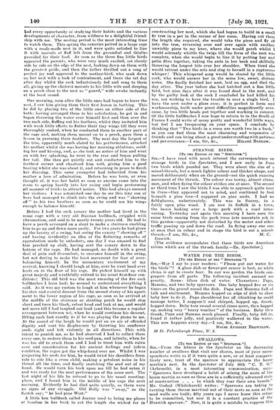SWALLOWS.
(To THE EDITOR OF THE "SPECTATOR.") SIR,—From the letters in the Spectator on the decreasing number of swallows that visit our shores, most of your corre- spondents write as if it were quite a new, or at least compara- tively new, trait of the sparrow to appropriate the house martin's nest. In the Spectator of July 16th "C. T. G." (Arbroath), in a most interesting communication, says: "Sparrows have developed a habit of seizing the nests of the house martin as soon as these are in a sufficiently advanced state of construction . . . in which they rear their own broods." Mr. Godsal (Whitchurch) writes: "Sparrows are taking to turning them (house martins) out of their nests as soon as the mud walls are built; fifty years ago I never knew this crime to be committed, but now it is a constant practice of the Hunnish sparrow." Now, it is quite a mistake to suppose this euckooish trick of -our old friend the sparrow is anything new : he was at it one hundred and fifty years ago at any rate, for we find White of Selborno writing : "Nothing is more common than for the house sparrow, as soon as the shell" of the house martin's nest "is finished, to seize on it as its own, to eject the owner, and to line it after its own manner." Seventy years ego Edward Jesse, the well-known naturalist, mentions that sparrows sometimes "invaded " the martin's nest, and that the martins sometimes returned in numbers and "pecked the stolen nests to pieces," and have been known to wait until the sparrow hen was sitting on her eggs, when they would return and, assisted by some of their friends, "close up the hole," suffocating the sparrow. Can anyone tell us if the martin still retains what Jesse calls its "revengeful disposition "2-1 am,



































 Previous page
Previous page